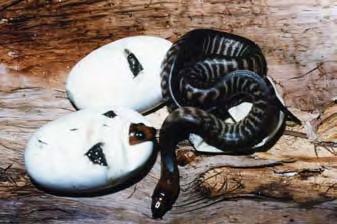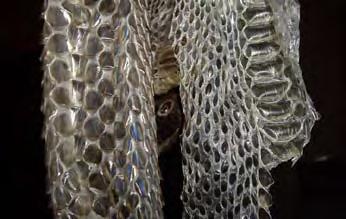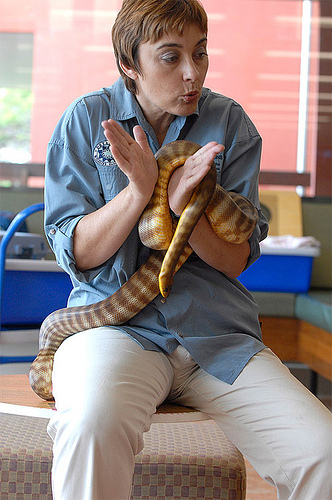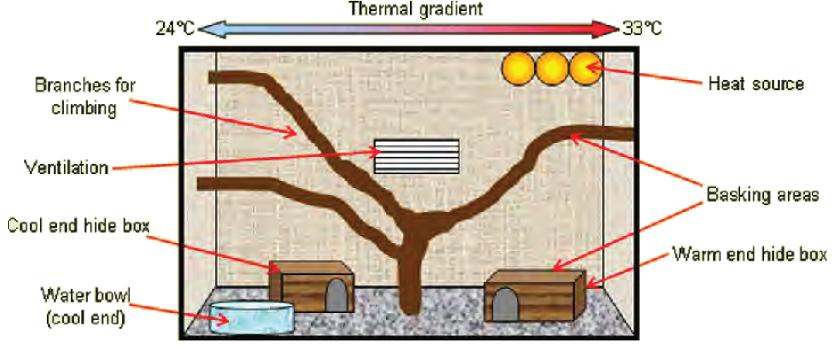For Beginners
/Guide to Pythons
by Andrew Owen
Pythons are increasing in popularity as pets in Australia and many species are now available. Keeping native species as pets is a good option ecologically and if the animals’ basic needs are met they can thrive in captivity. And so, the following discussions (guide to pythons) are strongly recommended.
Guide to Pythons: Housing
Pythons should be kept individually in a secure enclosure made from thermally efficient material (material that holds heat well like wood or plastic, not a glass fishtank). A glass front allows for viewing your animal. The diagram below illustrates a basic python set up and minimal requirements for a healthy animal. 
Guide to Pythons: Housing Hatchling/Juvenile Pythons
If you purchase a hatchling/juvenile python keep it in a “click-clack” (small, secure container) inside your enclosure until it is an appropriate size for the enclosure - this could be up to a year. Too many people get impatient and put their small python in an enclosure too early, only to have the animal escape through gaps around glass & vents, etc!
Guide to Pythons: Guide to enclosure size
|
Guide to Pythons: Arboreal python (tree dwelling) |
Guide to Pythons: Terrestrial python (ground dwelling) |
|
| Guide to Pythons: Length | ¾ of snake length | length Length of snake |
| Width | ½ of snake length | ¾ of snake length |
| Height | Length of snake | ½ of snake length |
Guide to Pythons: Substrate
Choice of substrate (the material on the bottom of your enclosure) varies. Small gravel can look nice, but cleaning time is increased. Newspaper is hygienically and practically best but not as visually pleasing.
Guide to Pythons: Feeding
Before purchasing your python make sure it has been feeding on thawed mice or rats. You may think it is boring feeding your pet the same meal but a mouse or rat has all the nutrients needed. If a python is happily feeding don’t change things.
Juveniles should be fed every 7-10 days, slowly increasing the size of the meal as your python grows. Adults should be fed a meal around 20% of their body weight every 2nd week (possibly more in summer and less or no food in winter). Pythons are predominantly nocturnal so feeding after dark is best. If your python refuses a feed, don’t be alarmed. Some don’t eat when they are about to shed and some will go off food in winter.
Guide to Pythons: Drinking Water
Drinking water should be available at all times to your Python. Refrain from simply topping up the water bowl as much as possible. A couple of times a week, remove the water bowl, empty & clean the bowl thouroughly, then re-fill with fresh water.
 Guide to Pythons: Shedding (Sloughing)
Guide to Pythons: Shedding (Sloughing)
Pythons shed their skin every couple of months or so, more frequently as they are growing. A sign of a healthy python in a good environment is its shed. A good, whole skin shed signals correct humidity and health. If a shed comes off in patches perhaps more cage furnishing with rough sections are required and more humidity. Greater humidity can be achieved by increasing the size of the water bowl or occasional light spraying of the enclosure with water. Any retained shed, in particular on the eyes and tail tip, must be removed.
Guide to Pythons: Handling
 When a new animal is purchased, introduce it to its new home and leave it alone until it is feeding and comfortable in its surroundings. If your snake is about to shed (signaled by milky eyes) leave it alone until shedding is complete. The snake’s eye sight is poor at this time and handling is stressful. After a feed leave your python alone to digest its meal and if you usually feed your python at night it is advisable not to handle it at night.
When a new animal is purchased, introduce it to its new home and leave it alone until it is feeding and comfortable in its surroundings. If your snake is about to shed (signaled by milky eyes) leave it alone until shedding is complete. The snake’s eye sight is poor at this time and handling is stressful. After a feed leave your python alone to digest its meal and if you usually feed your python at night it is advisable not to handle it at night.
|
Arboreal python (tree dwelling) |
Terrestrial python (ground dwelling) |
|
| Length | ¾ of snake length | length Length of snake |
| Width | ½ of snake length | ¾ of snake length |
| Height | Length of snake | ½ of snake length |


